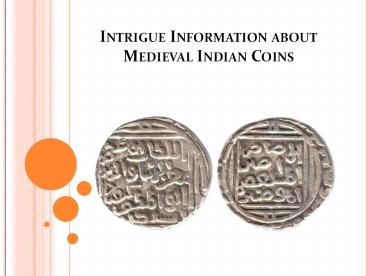Intrigue Information about Medieval Indian Coins - PowerPoint PPT Presentation
Title:
Intrigue Information about Medieval Indian Coins
Description:
If you are a researcher studying about Rare Antique British coins in India, Mintage World is the perfect site which provides organized and accurate information about Rare Coins of British India and colonial Coins based on time periods, rulers and dynasties. – PowerPoint PPT presentation
Number of Views:294
Title: Intrigue Information about Medieval Indian Coins
1
Intrigue Information about Medieval Indian Coins
2
Coins introduced during Medieval India
- The Arabs conquered Sindh in 712 AD and ruled it
as an area of the Caliphate. By the ninth Century
AD, common governors built up autonomous
administer and struck their own coins. In any
case, it was with the development of Turkish
Sultans of Delhi in the twelfth Century that a
conclusive break was made with the past and the
current themes were continuously supplanted by
Islamic gadgets, generally calligraphy. The unit
of record came to be combined and was alluded to
as the "tanka" with the "jittals" as the littler
esteem coins.
3
(No Transcript)
4
Delhi Sultanate Coins
- With the Delhi Sultanate (1206-1526 AD) came the
endeavor at standardization. This period was set
apart by an extensive development of the cash
economy. Coins were struck in gold, silver and
copper. The Khilji rulers issued coins in
plenitude with lofty titles (Ala-ud-clamor Khilji
struck coins expecting the title 'Sikandar al
Sani', the second Alexander) and also honorific
sobriquets for mints (the Delhi mint bore titles
'Hazrat Dar-al-Khilafat, etc.).
5
(No Transcript)
6
coins of the Tughlaqs (1320-1412 AD)
- The coins of the Tughlaqs (1320-1412 AD) were
better in design and execution than those of the
Khiljis. Muhammed Bin Tughlaq (1325-1351 AD),
appreciated his coinage nonetheless, his fiscal
trials were a disappointment and the reason for
much hopelessness. The main analysis was to make
his coinage reflect the gold/silver value
proportion winning in the free market. At the
point when this test fizzled the old gold and
silver coins of around 11 grams were
reintroduced. The following investigation was
enlivened by Chinese paper cash which had
impelled the advancement of exchange and trade.
Tughlaq endeavored to set up a trustee
arrangement of coinage between 1329 AD to 1332
AD. He endeavored to issue tokens of metal and
copper. These tokens bore the legends.
7
(No Transcript)
8
Vijayanagar Empire
- In the South, the Vijayanagar counterparts of the
Delhi Sultanate and Mughals, were the other
tradition whose cash introduces an uncommon case
of a standardized issue which later gave a model
to the European and English trading
organizations. The Kingdom of Vijayanagar was
established around 1336 AD by Harihara and Bukka
in the locale south of the River Krishna. The
Vijayanagar period saw the coming of European
merchants particularly the Portuguese.
Krishnadevaraya energized remote exchange and
this required more extensive utilization of coin.
Coins of the Vijayanagar kingdom were to a great
extent struck in gold and copper. Most
Vijayanagar gold coins bore a hallowed picture on
the front-side and the regal legend on the turn
around.
9
(No Transcript)
10
- Get to know the coins introduced during Medieval
period in India which reflects a rich history
about India. Explore about these coins through
well classified and detailed information about
coins of medieval India at Mintage World.































